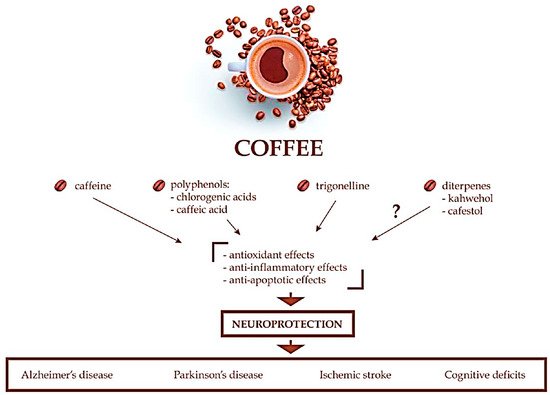You're using an outdated browser. Please upgrade to a modern browser for the best experience.
Please note this is an old version of this entry, which may differ significantly from the current revision.
Subjects:
Agronomy
Coffee is a Rubiaceae coffee plant ranked as the first of the three most important beverages in the world, with effects including lowering blood sugar, protecting the liver, and protecting the nerves. Coffee contains many chemical components, including alkaloids, phenolic acids, flavonoids, terpenoids, and so on. Chemical components in coffee are the basis of its biological function and taste.
- coffee
- biological activities
1. Bioactivity of Coffee
Coffee contains a large number of bioactive substances, with antioxidant, lipid-lowering, hypoglycemic, neuroprotective, and other biological activities.
2. Antioxidant Activity
Plant phenols are a large and diverse group, including cinnamic acid, benzoic acid, flavonoids, anthocyanins, stilbenes, coumarins, lignan compounds and lignins with different properties [60,61,62,63]. In in vitro tests, plant phenols are known to have strong antioxidant activity. Based on this, it is speculated that plant phenols may protect cell DNA and prevent free radical damage in the body. Since free radicals play an important role in inducing cardiovascular and cancer diseases, the consumption of plant polyphenols can effectively prevent the occurrence of such diseases.
A recent review report claims that four out of five epidemiological observational studies show that flavonols can prevent heart disease, but only one out of five studies show that it has the effect of preventing cancer. Therefore, the evidence obtained for the prevention of cancer by flavonols is obviously unconvincing. In addition, other types of plant polyphenols also need to be further investigated.
3. Lipid-Lowering Effect
3T3-L1 adipocytes were used to evaluate the effects of coffee fruits of different colors (green, yellow and red) on adipogenesis and/or lipolysis, and the results showed that green coffee fruits of different colors all had the activity of inhibiting adipogenesis in 3T3-L1 adipocytes [64]. Dried red coffee reduced fat accumulation by about 47%. In addition, all the main components of coffee extract (malic acid, quinic acid, and chlorogenic acid) except yellow fresh coffee increased the release of glycerol. At the same time, studies have also confirmed that coffee pulp can reduce cholesterol in vitro and in vivo by down-regulating LXRα activity modulated by NPC1L and inhibiting intestinal cholesterol absorption by micellar complex formation [65].
4. Lowering Blood Sugar
Diabetes mellitus (DM) is a chronic disease in which blood sugar levels increase due to relative or absolute lack of insulin. Drug therapy and diet management are the main treatments for diabetes. Caffeine, chlorogenic acid, trigonelline and other main components in coffee all have the effect of lowering blood sugar. The authors in [66] conducted a hypoglycemic effect study on small coffee and its leaf ethanol extract, and found that coffee extract can significantly reduce the blood sugar content of mice. Caffeol has potential anti-diabetic effects which can increase glucose-stimulated insulin secretion and increase the uptake of glucose by human skeletal muscle cells [67].
5. Neuroprotection
Epidemiological studies have shown that habitual coffee consumption may reduce the risk of Alzheimer’s disease [68], and the coffee intake of male patients with primary Parkinson’s disease is negatively correlated with the severity of tremor [69]. In the APP/PS2 transgenic mouse model of Alzheimer’s disease in Figure 1, However, many reports have shown that many compounds in coffee can independently have neuroprotective effects, suggesting that decaffeinated coffee is also effective against neurodegenerative diseases. Polyphenolic acids (i.e., chlorogenic and caffeic acids) and trigonelline appear to be the most promising, but unlike caffeine, there is a lack of epidemiological studies or clinical reports on their protective effects in neurodegenerative diseases.

Figure 1. Summary of the neuroprotective effects of coffee [1]. (Socała 2021).
6. Inflammatory, Cardiovascular Activity and Effects of Coffee on Sleep Wakefulness Cycle
The crude extract of coffee peel can protect and restore damaged human umbilical vein endothelial cells to a certain extent [70]. The combination of coffee extract and vitamin C can play an anti-tumor role [71]. The methanol extract of green coffee bean has certain anti-inflammatory activity [72]. Coffee has a protective effect on the liver, and coffee consumption can reduce the risk of HCC recurrence and increase the chance of survival after orthotopic liver transplantation [73]. Coffee was negatively associated with the risk of nonalcoholic fatty liver disease [74]. Studies suggest that the caffeine in a cup of coffee in the morning can not only keep you awake [75], but also help suppress inflammation, which is linked to risk factors for heart disease. Researchers have discovered an inflammatory response mechanism in some elderly people. It is produced in the human body, but not in elderly people. When it is heavily activated, people often have high blood pressure and severe atherosclerosis [76]. In laboratory tests, however, it has been shown that caffeine blocks this inflammatory process and that coffee also has a certain effect on the cardiovascular system. It is mainly caused by stimulating the sympathetic nerves of the heart and causing arousal. Symptoms such as tightness in the chest. The normal heart is innervated by the sympathetic and parasympathetic nervous systems [77]. When it is dormant at night, the parasympathetic nerve is usually the main stimulus. At this point it manifests as bradycardia and relatively low blood pressure. Try sympathetic nerve control during the day. Especially during physical exertion, emotional excitement and when drinking coffee, drinking, smoking and tea, the sympathetic nerves are stimulated to excite them, which leads to palpitations and tightness in the chest.
This entry is adapted from the peer-reviewed paper 10.3390/molecules26247634
This entry is offline, you can click here to edit this entry!
